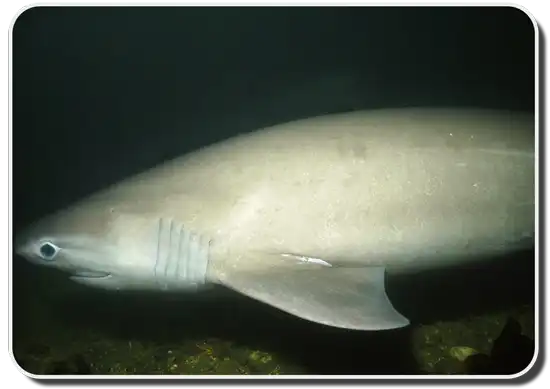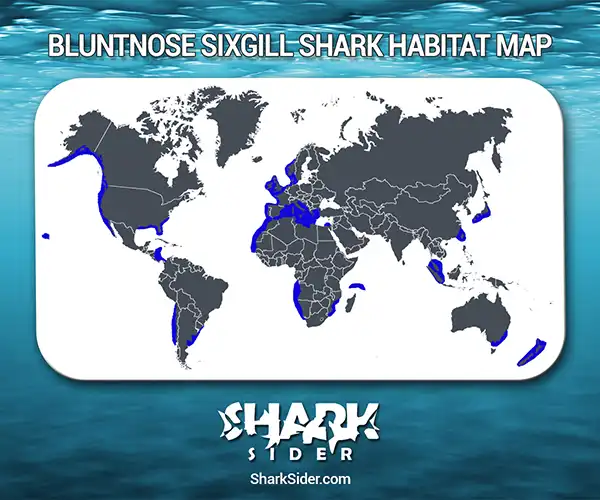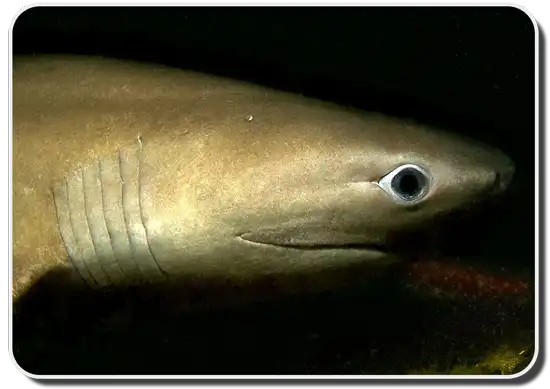The Bluntnose Sixgill Sharks are primitive sharks (genus Hexanchus) belonging to the Hexanchidae family (“Cow Sharks”). These deep-water predators are distinguished by the following features: they have six pairs of long gill slits on each side of their broad head, comb-like, yellow lower teeth, and a long tail.
The Bluntnose (H. griseus) is the larger of the two sixgill species, and indeed is one of the world’s largest sharks. It ranges widely in boreal, temperate and tropical seas. Its appearance is similar to Fossil Shark forms that date back roughly 200 million years, to the Triassic period. It has a blunt, rounded snout, and only a single dorsal fin. The skin color is dark, ranging from grayish brown to black on the back, fading toward the lighter belly. In life the eyes are bright green.]
The Latin name is handy for precision, because there are so many other common names for this shark: Atlantic Mud Shark, Brown Shark, Bull Dog Shark, Bull Shark, Cow Shark, Gray Shark, Grey Shark, Mud Shark, Sixgill Cow Shark, Sixgill Shark, and Sixgilled Shark. (Throughout the rest of this article, “Sixgill Shark” refers to H. griseus).
The biology and habits of this species are not well known, because of its deep-water lifestyle, although the species has been observed from research submersibles off Bermuda and California. We became more intrigued upon learning that “the Shark Lady”,Dr. Eugenie Clark, considers it to be one of her favorite shark species.
Bluntnose Sixgill Shark Facts
The common name comes from the presence of six gills, compared to the five found on most other sharks. This characteristic is something they have more in common with prehistoric shark forms than with modern-day sharks, along with the presence of a translucent eyelid and positioning of the dorsal fin closer to the tail.
The Sixgill Shark is a slow but strong swimmer. Although it is a fierce hunter, it still has to stay aware of its own predators. Potential threats include the Stellar’s sea lion (Eumetopias jubatus), killer whale (Orcinus orca), and the White Shark (Carcharodon carcharias).
The average length is roughly 4.8 m (16 ft), although some reported sightings suggest that individuals can grow longer. The maximum known mass is 590 kg (1,300 lbs).
Habitat and Range
Map Of The Bluntnose Sixgill Shark’s Habitat

This is one of the widest ranging sharks. It occurs on continental and island shelves in temperate and tropical seas around the world, in the Pacific, Atlantic, and Indian Oceans, although its distribution is patchy. It is considered a highly migratory species under the Convention on the Law of the Sea.
The Sixgill Shark prefers deep-water habitats, below 91 m (300 ft), though it can be found from the surface down to at least 2,000 m deep (about 6,500 ft). Adults have daily cycles of vertical migration: during the daytime they rest on the sea bottom, and at night they move into shallow waters or close to the surface to feed.
Sixgill Sharks have been known to feed on each other opportunistically, so researchers suggest that some mechanism for the spatial separation of larger and smaller individuals must be operating. Juveniles are believed to stay in shallower coastal waters, remaining in relatively small areas until they reach adolescence and move further down the slopes of the ocean floor into deeper water.
Feeding Behavior
Bluntnose Sixgill Sharks are strong predators. Adults are very sensitive to and become distressed by light exposure — thus, they spend the day in the dark depths, and forage closer to the surface mainly at night. They are generalists, feeding on a great variety of prey items that are likely ambushed at close range.
The diet includes other sharks, skates and rays, many kinds of large bony fish, and invertebrates including squid, crabs, sea cucumbers and shrimp. This shark has also been known to scavenge on dead animals such as seals, whales, and bait from long-lines set by fishermen.
Social Behavior
Typically the Sixgill Shark is observed on its own, and not in groups.
One aspect of its interactions with other species that has been studied is parasitism. Internal parasites of the shark that have been documented include nematodes and other parasitic worms within the digestive system. External parasites include copepods (tiny crustaceans) that feed on the shark’s head and fins. Of course these interactions might be better classified as “anti-social”
Breeding
 Male Sixgill Sharks become mature at about 3 m (10 ft) long, when they weigh about 200 kg (440 lbs). Females reach maturity at a larger size of roughly 4 m (13 ft) / 400 kg (880 lbs), and they ultimately grow to be larger than males. These sizes correspond to estimated ages of 11-14 years for males and 18-35 years for females. Individuals are thought to live up to 80 years. These are high ages of maturity and longevity for fish, however age determination is inexact, and studies would be required to confirm such estimates.
Male Sixgill Sharks become mature at about 3 m (10 ft) long, when they weigh about 200 kg (440 lbs). Females reach maturity at a larger size of roughly 4 m (13 ft) / 400 kg (880 lbs), and they ultimately grow to be larger than males. These sizes correspond to estimated ages of 11-14 years for males and 18-35 years for females. Individuals are thought to live up to 80 years. These are high ages of maturity and longevity for fish, however age determination is inexact, and studies would be required to confirm such estimates.
Mating and courtship is though to occur in deep-water habitats. Then, females move to shallower nursing areas to give birth on upper slopes and outer continental shelves. Actual courtship and mating behaviors have not been observed, however.
The breeding system of this species is ovoviparity, with eggs hatching inside the mother. Reports of litter sizes vary widely, although what is certain is that the litter is unusually large, including from 22 to 108 pups. They are born after a long gestation period, estimated to last from 12-24 months. Pups are about 60-75 cm (23-30″) long at birth.
Humans and Conservation
The Bluntnose Sixgill Shark is not known to target humans. According to the “International Shark Attack File”, only one provoked attack has been reported since the 1500s.
In fact, this species appears to tolerate the presence of people. Divers regularly observe immature sharks in the shallower waters off Canada’s Pacific coast. The sharks have been known to approach and examine divers (southern Vancouver Island, BC) and even surfers (Cannon Beach, OR) without threat or physical contact. However, they apparently snap when touched or caught by fishers, and they will swim away into deeper waters if surrounded by many divers.
The Sixgill is fished commercially and for sport throughout its range. The meat is sold fresh, frozen, salted, and sometimes smoked for export to European markets. This shark is also used for liver oil, fishmeal, and pet foods. Because it is a relatively sluggish species that uses a variety of depths, it is often captured accidentally in fisheries for other species (e.g. it is caught regularly as bycatch in the halibut and spiny dogfish fisheries of western Canada).
For some historical insight into fishing trends for this species: it has been the focus of at least three known commercial fisheries in Canadian waters. The first (early 1920s) was for skins to make shark leather. The second (1937 to 1946) was for shark livers to obtain vitamin A. The final fishery (late 1980s/early 1990s) but was stopped because of conservation concerns.
This considered a Species at Risk in Canada, where it is listed as “Special Concern”. The IUCN Red List assessed it as “Near Threatened” (2005), as it appears to be very vulnerable to overfishing. Efforts to develop directed fisheries for this shark have failed in California, usually lasting fewer than three years. Overfishing has caused depletion of regional populations, such as in the waters of the northeast Pacific. The Sixgill populations of San Francisco and Humboldt Bays (CA) and Puget Sound (WA) have declined greatly as a result. Development of a new fishery in British Columbia is being considered as a replacement for other bony fish and shark fisheries that are declining, despite strong the opposition of fisheries biologists.
Unfortunately reliable population data are not available for many regions. In some instances information doesn’t exist – it is general challenging to measure aquatic populations, and even more so for deep water fish. As an example, it is known that Sixgill Sharks are well distributed throughout much of Canada’s Pacific waters, yet there are no population data for the region. The historic population size in the northeast Pacific was thought to be approximately 8000, using genetic estimates, yet these numbers are uncertain. Encounter rates with immature sharks at one BC site have declined by more than 90% in recent years, according to video footage and diving records.
Better population estimates are clearly needed to facilitate management of this species. As is true for sharks in general, the bigger challenge at hand is garnering public and political support for protecting shark populations.
Written By: Kara Lefevre
Sources
Cook SF & Compagno LJV (2005). Hexanchus griseus. In: IUCN 2012. IUCN Red List of Threatened Species. Version 2012.2.
COSEWIC 2007. COSEWIC assessment and status report on the Bluntnose Sixgill Shark Hexanchus griseus in Canada. Committee on the Status of Endangered Wildlife in Canada. Ottawa. vii + 33 pp.
Fisheries and Oceans Canada (DFO)
